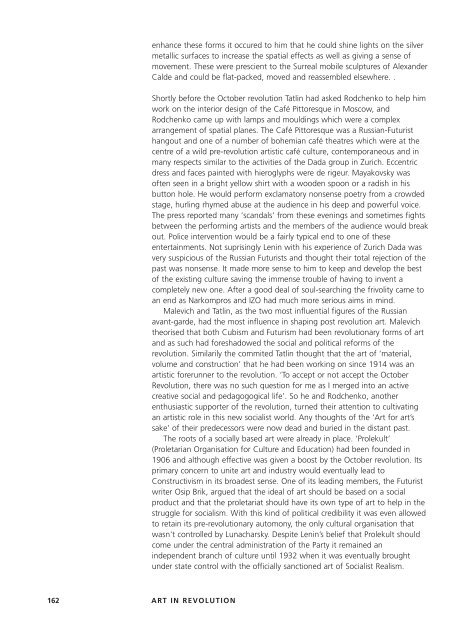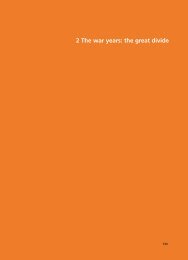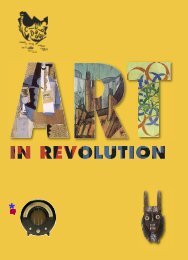Art in Revolution 3 - newleafdesign.me.uk
Art in Revolution 3 - newleafdesign.me.uk
Art in Revolution 3 - newleafdesign.me.uk
You also want an ePaper? Increase the reach of your titles
YUMPU automatically turns print PDFs into web optimized ePapers that Google loves.
enhance these forms it occured to him that he could sh<strong>in</strong>e lights on the silver<strong>me</strong>tallic surfaces to <strong>in</strong>crease the spatial effects as well as giv<strong>in</strong>g a sense ofmove<strong>me</strong>nt. These were prescient to the Surreal mobile sculptures of AlexanderCalde and could be flat-packed, moved and reassembled elsewhere. .Shortly before the October revolution Tatl<strong>in</strong> had asked Rodchenko to help himwork on the <strong>in</strong>terior design of the Café Pittoresque <strong>in</strong> Moscow, andRodchenko ca<strong>me</strong> up with lamps and mould<strong>in</strong>gs which were a complexarrange<strong>me</strong>nt of spatial planes. The Café Pittoresque was a Russian-Futuristhangout and one of a number of bohemian café theatres which were at thecentre of a wild pre-revolution artistic café culture, contemporaneous and <strong>in</strong>many respects similar to the activities of the Dada group <strong>in</strong> Zurich. Eccentricdress and faces pa<strong>in</strong>ted with hieroglyphs were de rigeur. Mayakovsky wasoften seen <strong>in</strong> a bright yellow shirt with a wooden spoon or a radish <strong>in</strong> hisbutton hole. He would perform exclamatory nonsense poetry from a crowdedstage, hurl<strong>in</strong>g rhy<strong>me</strong>d abuse at the audience <strong>in</strong> his deep and powerful voice.The press reported many ‘scandals’ from these even<strong>in</strong>gs and so<strong>me</strong>ti<strong>me</strong>s fightsbetween the perform<strong>in</strong>g artists and the <strong>me</strong>mbers of the audience would breakout. Police <strong>in</strong>tervention would be a fairly typical end to one of theseenterta<strong>in</strong><strong>me</strong>nts. Not supris<strong>in</strong>gly Len<strong>in</strong> with his experience of Zurich Dada wasvery suspicious of the Russian Futurists and thought their total rejection of thepast was nonsense. It made more sense to him to keep and develop the bestof the exist<strong>in</strong>g culture sav<strong>in</strong>g the im<strong>me</strong>nse trouble of hav<strong>in</strong>g to <strong>in</strong>vent acompletely new one. After a good deal of soul-search<strong>in</strong>g the frivolity ca<strong>me</strong> toan end as Narkompros and IZO had much more serious aims <strong>in</strong> m<strong>in</strong>d.Malevich and Tatl<strong>in</strong>, as the two most <strong>in</strong>fluential figures of the Russianavant-garde, had the most <strong>in</strong>fluence <strong>in</strong> shap<strong>in</strong>g post revolution art. Malevichtheorised that both Cubism and Futurism had been revolutionary forms of artand as such had foreshadowed the social and political reforms of therevolution. Similarily the commited Tatl<strong>in</strong> thought that the art of ‘material,volu<strong>me</strong> and construction’ that he had been work<strong>in</strong>g on s<strong>in</strong>ce 1914 was anartistic forerunner to the revolution. ‘To accept or not accept the October<strong>Revolution</strong>, there was no such question for <strong>me</strong> as I <strong>me</strong>rged <strong>in</strong>to an activecreative social and pedagogogical life’. So he and Rodchenko, anotherenthusiastic supporter of the revolution, turned their attention to cultivat<strong>in</strong>gan artistic role <strong>in</strong> this new socialist world. Any thoughts of the ‘<strong>Art</strong> for art’ssake’ of their predecessors were now dead and buried <strong>in</strong> the distant past.The roots of a socially based art were already <strong>in</strong> place. ‘Prolekult’(Proletarian Organisation for Culture and Education) had been founded <strong>in</strong>1906 and although effective was given a boost by the October revolution. Itsprimary concern to unite art and <strong>in</strong>dustry would eventually lead toConstructivism <strong>in</strong> its broadest sense. One of its lead<strong>in</strong>g <strong>me</strong>mbers, the Futuristwriter Osip Brik, argued that the ideal of art should be based on a socialproduct and that the proletariat should have its own type of art to help <strong>in</strong> thestruggle for socialism. With this k<strong>in</strong>d of political credibility it was even allowedto reta<strong>in</strong> its pre-revolutionary automony, the only cultural organisation thatwasn't controlled by Lunacharsky. Despite Len<strong>in</strong>’s belief that Prolekult shouldco<strong>me</strong> under the central adm<strong>in</strong>istration of the Party it rema<strong>in</strong>ed an<strong>in</strong>dependent branch of culture until 1932 when it was eventually broughtunder state control with the officially sanctioned art of Socialist Realism.162 ART IN REVOLUTION





